Family

Rudra Shumsher Jung Bahadur Rana was an erstwhile field-marshal and the Western Commander-in-Chief of Nepal. He was the third son of Bir Shumsher Jung Bahadur Rana and in line to be the Prime Minister of Nepal. He was exiled to the Palpa District, where he was made the district's Tainathwalla (chief administrative official). He held this position from 1934 till 1951 and was the last Tainathwalla ever appointed in the Palpa District. [1] He rebuilt the Char Burja Durbar which Bir Shumsher JBR had given him after it was destroyed by fire in 1962 BS.

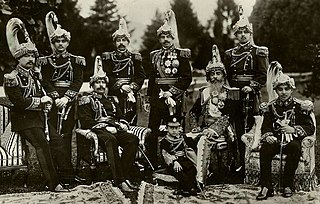
The Rana dynasty was a Chhetri dynasty that imposed authoritarianism in the Kingdom of Nepal from 1846 until 1951, reducing the Shah monarch to a figurehead and making the Prime Minister and other government positions held by the Ranas hereditary. The Rana dynasty is historically known for their iron-fisted rule in Nepal. This changed after the Revolution of 1951 with the promulgation of a new constitution, when power shifted back to the monarchy of King Tribhuvan.
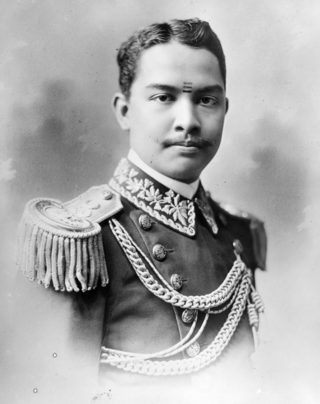
Field Marshal Sir Kaiser Shumsher Jang Bahadur Rana, GBE was a field marshal in the Royal Nepalese Army. He was the third son of Maharaja Sir Chandra Shamsher Jang Bahadur Rana, GCB, GCSI, GCMG, GCVO the fifth Prime Minister of Nepal of the Rana dynasty and Bada Maharani Chandra Loka Bhaktha Rajya Lakshmi.
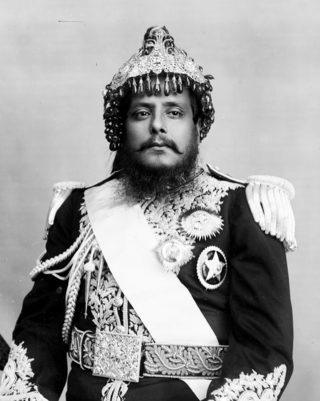
Commanding General Shree Maharaja Sir Bir Shumsher Jung Bahadur Rana was the 11th Prime Minister of Nepal. He is remembered as a statesman who made reforms and infrastructure improvements. Bir Shamsher Jung Bahadur Rana was known as Kailay in his childhood; this name was given by Jung Bahadur. His mother was daughter of Pahalman Singh Basnyat and sister of Lalitman Singh Basnyat. His mother died at his birth and he was taken care of by Putali Maharani, wife of Jung Bahadur. He spent his childhood at Thapathali Durbar.
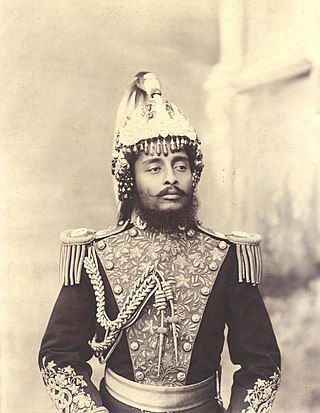
Field-Marshal His Highness Maharaja Sri Teen Chandra Shumsher Jung Bahadur Rana was the Prime Minister of Nepal from the Rana dynasty. He served in this capacity from 27 June 1901 to his death in 1929 after he successfully deposed his liberal and reformist brother Dev Shamsher. Although generally perceived as despotic and conservative, he is credited with several reforms including the abolition of slavery and establishing the Nepal-Britain Treaty of 1923, which recognised Nepal as an independent nation and an ally of Britain.
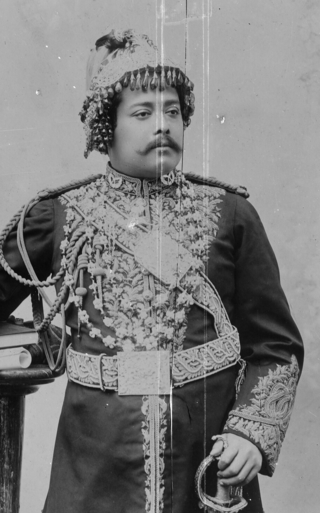
Sri Maharaja, Dev Shumsher Jung Bahadur Rana was the Prime Minister of Nepal for 114 days in 1901. He was also the King of Lamjung and Kaski.
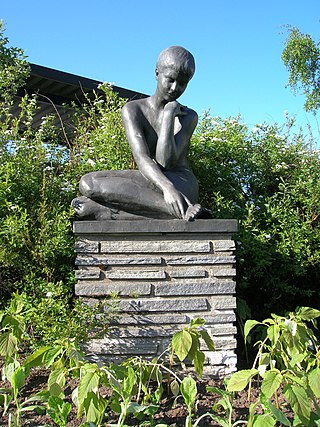
Rana is a given name and surname of multiple origins.
Diamond Shumsher Rana was a Nepali writer and political activist known for his acclaimed novels Basanti and Seto Bagh.
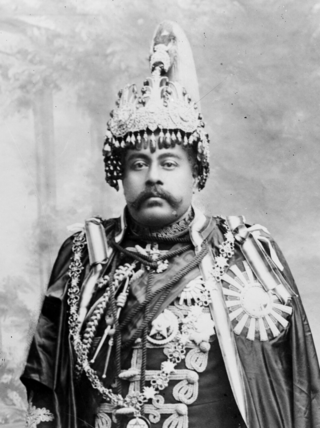
Field Marshal Shri Shri Shri Maharaja Sir Juddha Shumsher Jung Bahadur Rana GCB GCSI GCIE was the Prime Minister of Nepal from 1 September 1932 to 29 November 1945 as the head of the Rana dynasty.
Toran Shumsher Jung Bahadur Rana was the first police chief of Nepal Police after the establishment of the force in the year 2007 B.S. However, he only remained chief for three days before Nara Shumsher J.B.R. succeeded him as the police chief.

Ranighat Palace or Rani Mahal is a historic Rana palace located on the banks of Kali Gandaki River in Palpa district of Nepal. This palace was constructed by General Khadga Shamsher Jang Bahadur Rana in 1893.
Shishir S.J.B Rana is a Nepalese actor, producer, director and writer who appeared in several Nepali movies and television serials such as Madan Bahadur Hari Bahadur, Tito Satya, Jire Khursani, Meri Bassai and Jhyaikuti jhayai. He was born in Kathmandu, Nepal. He did his schooling from Birendra Sainik Awasiya Mahavidyalaya, Bhaktapur. He started his career as an Assistant Director in movie Chokho Maya in year 1991 AD. Later he worked as a production manager in many Nepali films and also worked as a model and Line producer in Nepali Advertisement industry. He won best screen play and best film award for his debut directional film 'Timi Sanga'.
Nir Shumsher Jung Bahadur Rana. Field Marshal and retired General of the Nepal Army (NA). Born on 11 Poush, 1970 B.S. (1913) in Jawalakhel Durbar, Jawalakhel, Lalitpur, Field Marshal Rana died at the age of 99. He was son of the then ruling Rana Prime Minister Juddha Shumsher Rana and his second wife, Mahila Maharani Krishna Kumari. According to a statement, the centenarian Field Marshal had joined the then Royal Nepal Army (RNA) at the age of 18 on 1 Shrawan 1988 B.S (1931) and was appointed to the post of Major at the Shri Pashupati Prasad Battalion. He became the Commander-in-Chief of the RNA on 15 Baisakh, 2017 B.S (1960) and retired on 15 Baisakh in 2022 B.S (1965). He was appointed Field Marshal after his retirement in 2022 B.S.

Bahadur Bhawan is a Rana palace in Kathmandu, the capital of Nepal. The palace complex, located west of Jamal, north of Keshar Mahal was incorporated in an impressive and vast array of courtyards, gardens and buildings. The palace was built by Bir Shumsher JBR and rebuilt by Rudra Shumsher JBR after its destruction by fire in BS 1962.

Dhir Shumsher Kunwar, after 1848 known as Dhir Shumsher Kunwar Ranaji or Dhir Shumsher Jang Kunwar Ranaji or shortly Dhir Shumsher Rana posthumously known as Dhir Shumsher Jang Bahadur Rana, was a Nepalese politician, army general, and minister of state. He served as the Commander-In-Chief of the Nepalese Army from 1879 to 1884.
Krishna Bahadur Kunwar, after 1848 CE known as Krishna Bahadur Kunwar Rana, was a Nepalese politician, administrator, military general and minister of state. He served as the acting Prime Minister of Nepal upon the demise of his elder brother Bam Bahadur Kunwar from 25 May 1857 to 28 June 1857. He also served as the Commander-In-Chief of the Nepalese Army between 1857 and 1862.

Rana Shumsher Rana was the Commander-In-Chief of the Nepalese Army from March 1887 to June 1887.
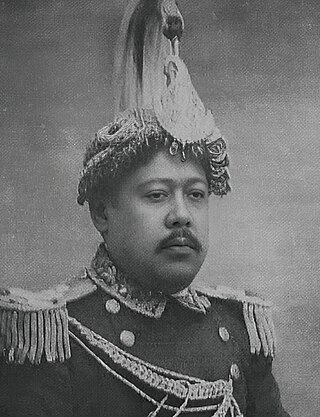
Dambar Shumsher Jung Bahadur Rana (Nepali: डम्बर शमशेर जङ्गबहादुर राणा; also known as Sano Maila ; 1859–1922 was First Nepalese Photographer, Military General, and Courtier in the Kingdom of Nepal.
Lamjung and Kaski was a state which was given to His Highness Shree Tin Maharaja Jung Bahadur Rana in 1856 by His Majesty King Surendra Bir Bikram Shah.
Shumsher is a given name popular in Nepal, and was carried by most of the Rana dynasty. Notable people with the surname include: